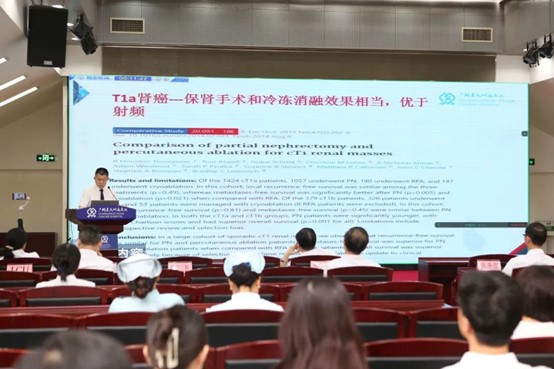Malignant kidney tumors account for approximately 2%-3% of adult malignancies. In the urinary system, the incidence rate of kidney cancer is second only to bladder cancer, with renal cell carcinoma being the most common type. At the time of diagnosis, 20%-30% of patients already have metastases. For recurrent or stage IV and inoperable patients, radiotherapy and chemotherapy are ineffective, with a five-year survival rate of less than 10%. In recent years, ablation therapy has played an important role in the treatment of renal tumors, offering new treatment options for patients. Dr. Liang Bing, Vice President of Fuda Cancer Hospital in Guangzhou, shared insights on cryoablation therapy for kidney cancer.

Ablation Therapy for Kidney Cancer
Since Zegel et al. first clinically applied cryoablation to treat kidney cancer in 1998, it has become a significant advancement in minimally invasive treatments following laparoscopic surgery. This includes techniques such as radiofrequency, cryoablation, microwave, laser, HIFU (High-Intensity Focused Ultrasound) ablation, and irreversible electroporation, all of which have been successfully applied in clinical settings. These methods are effective, preserve more normal kidney units, are simple to operate, well-tolerated by patients, require short hospital stays, enable quick recovery, and result in fewer complications. Among these, image-guided percutaneous radiofrequency, cryoablation, and microwave ablation are the most mature applications.
Ablation therapy has been recommended for T1a stage kidney cancer by several authoritative international guidelines, including the Chinese Clinical Oncology Society (CSCO) Kidney Cancer Management Guidelines, the National Comprehensive Cancer Network (NCCN) Guidelines, the American Urological Association (AUA) Guidelines, the European Association of Urology (EAU) Guidelines, and the European Society for Medical Oncology (ESMO) Guidelines.
Comparative evaluations of percutaneous ablation, laparoscopic ablation, and partial nephrectomy for T1a kidney cancer show no significant difference in efficacy between the three ablation techniques. Surgical treatment has a lower local recurrence rate and a better overall survival rate than ablation, but there is no difference in kidney cancer-specific survival between ablation and surgery. Additionally, ablation has fewer complications.
Cryoablation for Kidney Cancer
Cryotherapy originated in the 19th century when James Arnott used salt and crushed ice to alleviate tumor pain and bleeding. Today, cryoablation technology is mature in clinical applications. Open kidney cryoablation was first used by Delworth et al. in 1996 to treat isolated kidney tumors with good efficacy and no significant postoperative discomfort.

Compared with radiofrequency and microwave ablation, cryoablation has a lower recurrence rate, is safer, and causes less pain. Its principle involves rapidly lowering the temperature to destroy tumor tissue. When the tissue is rewarmed, the thermodynamic instability causes intracellular ice crystals to further grow, enhancing mechanical destruction of tumor cells. The necrotic cells release antigens after rewarming, which are presented by dendritic cells (DC) to activate T cells, generating an immune response to fight the tumor. This method is minimally invasive, has a quick recovery time, can be repeated, has a broad range of indications, and provides precise treatment.
Indications and Contraindications
Indications:
Renal tumors with a maximum diameter of ≤4 cm (cT1a stage).
Patients in poor overall condition who cannot tolerate general anesthesia or have deep-seated tumors with high bleeding risk during partial nephrectomy.
Patients with congenital/functional solitary kidney, where conventional surgery may cause renal insufficiency or require dialysis.
Patients refusing surgery or with recurrent tumors after conventional surgery.
Patients with multiple tumor lesions refusing radical resection.
Stable or reduced lesions after other targeted or immunotherapy, requiring ablation to consolidate efficacy.
Contraindications:
Patients in extremely poor overall condition with multi-organ failure or terminal stage.
Severe coagulation disorders; patients taking anticoagulants or anti-angiogenic drugs.
Large tumors that cannot be completely ablated even with multiple needles.
Tumors near the renal hilum with potential complications such as injury to major renal vessels or ureter.
Lesions involving surrounding organs where ablation would be ineffective or unsafe.
All primary tumors should undergo biopsy to confirm pathological diagnosis, which can be done concurrently with or before ablation. It is essential to maintain patient body temperature during the procedure, and a thermal blanket may be used if necessary.

Currently, local ablation for cT1a stage renal cell carcinoma is widely accepted internationally, offering survival rates similar to surgical resection with fewer complications. This approach may challenge partial nephrectomy (PN) as the new standard treatment in the future.
Furthermore, some studies have shown that the necrotic tissue after ablation might have immunogenic properties, stimulating the body's anti-tumor immune response. Cryoablation can control the primary tumor and induce specific or non-specific anti-tumor reactions, causing metastases and other tumors to disappear or shrink spontaneously. Combining this with immune checkpoint inhibitors could potentially enhance the anti-tumor effect, possibly becoming a new treatment modality in the future.